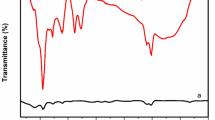Abstract
Supercapacitor is a promising electrochemical energy-storage device, which has the advantage of good cycle stability, short charging time, and high power density, so it has broad application prospects. Electrode as a core component has an important influence on the specific capacitance and performance of the supercapacitor. In this study, a series of reduced graphene oxide/polyaniline/polyvinyl alcohol (RGO/PANI/PVA) nanofibers with different RGO concentrations were synthesized by electrospinning method and then studied as electrode materials for supercapacitors. The experimental result reveals that the PANI/PVA nanofiber shows the pseudocapacitance properties, while the RGO/PANI/PVA nanofibers exhibit the electrochemical properties of the double-layer capacitor. In addition, the RGO/PANI/PVA nanofibers have a uniform diameter distribution of 119.8 nm without beads and droplets sticking when the concentration of RGO is 0.2%. This morphology contributes to a large specific surface area of fibers and provides sufficient channels for the transport of ions. RGO/PANI/PVA nanofibers exhibit better specific capacitance of 174 F/g when compared with the PANI/PVA (105 F/g). The research indicates that RGO/PANI/PVA nanofibers with high specific capacitance can provide a promising application as supercapacitor electrodes.









Similar content being viewed by others
References
S.L. Chiam, H.N. Lim, S.M. Hafiz, A. Pandikumar, N.M. Huang, Electrochemical performance of supercapacitor with stacked copper foils coated with graphene nanoplatelets. Sci. Rep. 8(1), 3093 (2018)
J.S. Shayeh, P. Norouzi, M.R. Ganjali, Studying the supercapacitive behavior of a polyaniline/nano-structural manganese dioxide composite using fast Fourier transform continuous cyclic voltammetry. RSC Adv. 5(26), 20446–20452 (2015)
P. Simon, Y. Gogotsi, Materials for electrochemical capacitors. Nat Mater. 7(11), 845–854 (2008)
Q. Meng, K. Cai, Y. Chen, L. Chen, Research progress on conducting polymer based supercapacitor electrode materials. Nano Energy 36, 268–285 (2017)
A.G. Pandolfo, A.F. Hollenkamp, Carbon properties and their role in supercapacitors. J. Power Source. 157(1), 11–27 (2006)
H. Zhou, H. Chen, S. Luo, G. Lu, W. Wei, Y. Kuang, The effect of the polyaniline morphology on the performance of polyaniline supercapacitors. J. Solid State Electrochem. 9(8), 574–580 (2005)
S. Ghobadi, S. Sadighikia, M. Papila, F.C. Cebeci, S.A. Gursel, Graphene-reinforcedpoly (vinyl alcohol) electrospun fibers as building blocksfor high performancenanocomposites. RSC Adv. 5(103), 85009–85018 (2015)
D. Gui, C. Liu, F. Chen, J. Liu, Preparation of polyaniline/graphene oxide nanocomposite for the application of supercapacitor. Appl. Surf. Sci. 307, 172–177 (2014)
J.S. Shayeh, A. Ehsani, M.R. Ganjali, P. Norouzi, B. Jaleh, Conductive polymer/reduced graphene oxide/au nano particles as efficient composite materials in electrochemical supercapacitors. Appl. Surf. Sci. 353, 594–599 (2015)
Y. Jiang, Z.M. Chen, B. Xin et al., Fabrication and characterization of flexible electrochromic membrane based on polyaniline/reduced graphene oxide. J. Mater. Res. 34(10), 1302–1308 (2019)
Q. Liu, J. Zhu, L. Zhang, Y. Qiu, Recent advances in energy materials by electrospinning. Renew. Sustain. Energy Rev. 81(2), 1825–1858 (2018)
Z.M. Huang, Y.Z. Zhang, M. Kotaki, S. Ramakrishna, A review on polymer nanofibers by electrospinning and their applications in nanocomposites. Compos. Sci. Technol. 63(15), 2223–2253 (2003)
Q.P. Pham, U. Sharma, A.G. Mikos, Electrospinning of polymeric nanofibers for tissue engineering applications: a review. Tissue Eng. 12(5), 1197–1211 (2006)
N.J. Pinto, A.T. Johnson, A.G. Macdiarmid, C.H. Mueller, N. Theofylaktos, D.C. Robinson et al., Electrospun polyaniline/polyethylene oxide nanofiber field-effect transistor. Appl. Phys. Lett. 83(20), 4244 (2003)
K.T. Peter, A.J. Johns, N.V. Myung et al., Functionalized polymer-iron oxide hybrid nanofibers: Electrospun filtration devices for metal oxyanion removal. Water Res. 117, 207–217 (2017)
L.C. Tsai, C.T. Pan, C.K. Yen, S.Y. Wang, & Z.H. Wen. Study of the drug fiber for wound healing by direct-writing near field electrospinning with subdivision control. 2017 International Conference on Applied System Innovation (ICASI). IEEE. (2017)
X. Lu, C. Wang, F. Favier, N. Pinna, Electrospun nanomaterials for supercapacitor electrodes: designed architectures and electrochemical performance. Adv Energy Mater. 7(2), 160 (2017)
A. Rose, K.P. Guru, T. Sakthivel et al., Electrochemical analysis of graphene oxide/polyaniline/polyvinyl alcohol composite nanofibers for supercapacitor applications. Appl. Surf. Sci. 449, 551–557 (2018)
S. Chaudhari, Y. Sharma, P.S. Archana, R. Jose, S. Ramakrishna, S. Mhaisalkar et al., Electrospun polyaniline nanofibers web electrodes for supercapacitors. J. Appl. Polym. Sci. 129(4), 1660–1668 (2013)
J. Bhadra, N.K. Madi, N.J. Al-Thani, M.A. Al-Maadeed, Polyaniline/polyvinyl alcohol blends: effect of sulfonic acid dopants on microstructural, optical, thermal and electrical properties. Synth. Met. 191, 126–134 (2014)
M. Fahimeh, F. Javad, N. Sina, R. Joselito, N. Minoo, Nanostructured electrospun hybrid graphene/polyacrylonitrile yarns. Nanomaterials. 7(10), 293 (2017)
P. Frontera, C. Busacca, S. Trocino, P. Antonucci, M.L. Faro, E. Falletta et al., Electrospinning of polyaniline: effect of different raw sources. J. Nanosci. Nanotechnol. 13(7), 4744–4751 (2013)
G. Cai, J. Tu, D. Zhou, J. Zhang, Q. Xiong, X. Zhao, X. Wang, C. Gu, Multicolor electrochromic film based on TiO2/polyaniline core/shell nanorod array. J. Phys. Chem. C 117(31), 15967–15975 (2013)
Y. Wang, X. Yang, L. Qiu, D. Li, Revisiting the capacitance of polyaniline by using graphene hydrogel films as a substrate: the importance of nano-architecturing. Energy Environ. Sci. 6(2), 477–481 (2013)
Acknowledgements
The authors gratefully acknowledge the financial support by Research Initiation Funds of Shanghai University of Engineering Science (2016-27), Student Research Innovation Training Program-SUES (cs1809004), Young Scholar Training Scheme of Shanghai Universities (ZZGCD16028), 2017 Talents Action Program of Shanghai University of Engineering Science (2017RC432017), and Shanghai Local Capacity-Building Project (No. 19030501200).
Author information
Authors and Affiliations
Corresponding authors
Additional information
Publisher's Note
Springer Nature remains neutral with regard to jurisdictional claims in published maps and institutional affiliations.
Rights and permissions
About this article
Cite this article
Chen, Z., Jiang, Y., Xin, B. et al. Electrochemical analysis of conducting reduced graphene oxide/polyaniline/polyvinyl alcohol nanofibers as supercapacitor electrodes. J Mater Sci: Mater Electron 31, 5958–5965 (2020). https://doi.org/10.1007/s10854-020-03204-1
Received:
Accepted:
Published:
Issue Date:
DOI: https://doi.org/10.1007/s10854-020-03204-1




